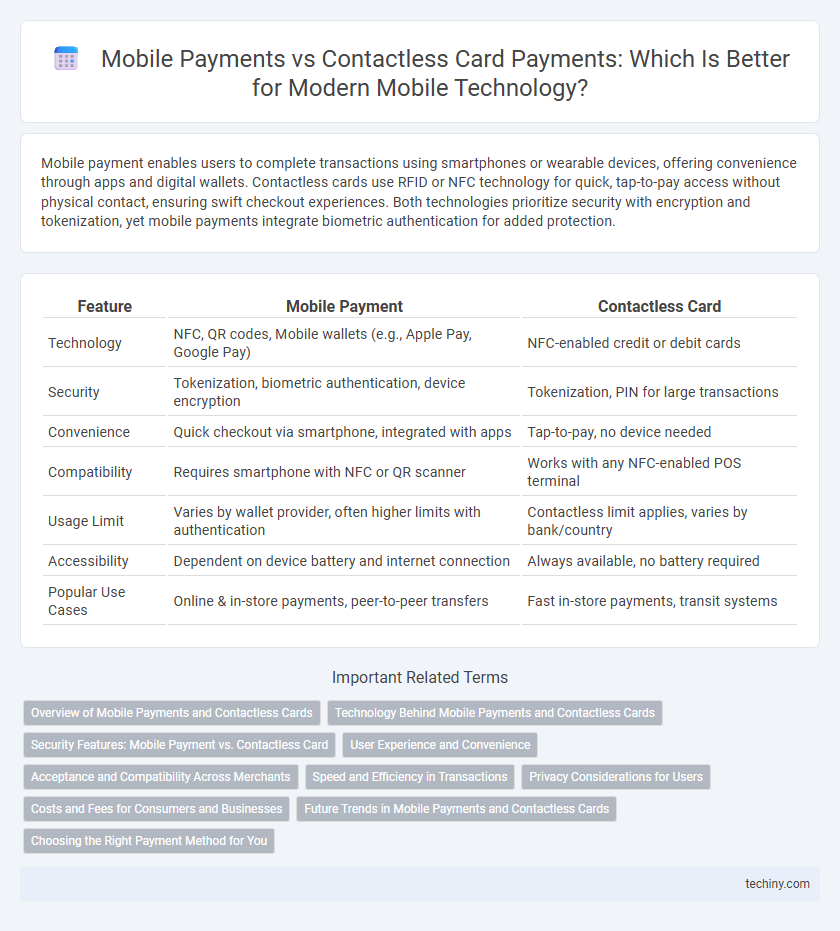Mobile payment enables users to complete transactions using smartphones or wearable devices, offering convenience through apps and digital wallets. Contactless cards use RFID or NFC technology for quick, tap-to-pay access without physical contact, ensuring swift checkout experiences. Both technologies prioritize security with encryption and tokenization, yet mobile payments integrate biometric authentication for added protection.
Table of Comparison
| Feature | Mobile Payment | Contactless Card |
|---|---|---|
| Technology | NFC, QR codes, Mobile wallets (e.g., Apple Pay, Google Pay) | NFC-enabled credit or debit cards |
| Security | Tokenization, biometric authentication, device encryption | Tokenization, PIN for large transactions |
| Convenience | Quick checkout via smartphone, integrated with apps | Tap-to-pay, no device needed |
| Compatibility | Requires smartphone with NFC or QR scanner | Works with any NFC-enabled POS terminal |
| Usage Limit | Varies by wallet provider, often higher limits with authentication | Contactless limit applies, varies by bank/country |
| Accessibility | Dependent on device battery and internet connection | Always available, no battery required |
| Popular Use Cases | Online & in-store payments, peer-to-peer transfers | Fast in-store payments, transit systems |
Overview of Mobile Payments and Contactless Cards
Mobile payments enable users to complete transactions using smartphones or wearable devices through apps and digital wallets such as Apple Pay, Google Pay, and Samsung Pay, offering enhanced security features like tokenization and biometric authentication. Contactless cards utilize Near Field Communication (NFC) technology to allow quick, tap-and-go payments without the need for PIN entry under certain limits, widely accepted by retailers worldwide. Both methods streamline the checkout process, improve transaction speed, and reduce physical card handling, contributing to the growth of cashless economies.
Technology Behind Mobile Payments and Contactless Cards
Mobile payments leverage Near Field Communication (NFC) technology integrated into smartphones, enabling secure transactions via encrypted tokenization and biometric authentication. Contactless cards also use NFC but rely on embedded secure elements within the card chip to transmit encrypted payment data during a tap. Both technologies utilize secure communication protocols like EMV (Europay, MasterCard, and Visa) standards, though mobile payments often enhance security through multi-factor verification and dynamic cryptograms.
Security Features: Mobile Payment vs. Contactless Card
Mobile payment systems utilize advanced encryption protocols and biometric authentication such as fingerprint or facial recognition to enhance transaction security, reducing the risk of fraud and unauthorized access. Contactless cards rely on near-field communication (NFC) technology with tokenization to protect card details, but lack the multi-factor authentication layers found in mobile wallets. Continuous software updates in mobile payment apps provide dynamic security enhancements, whereas contactless cards have fixed hardware security, making mobile payments more adaptive against evolving cyber threats.
User Experience and Convenience
Mobile payment offers seamless integration with smartphones, enabling quick transactions without the need to carry physical cards, enhancing user convenience especially in fast-paced environments. Contactless cards provide ease with simple tap-to-pay functionality and do not rely on battery power or device compatibility, ensuring consistent reliability. Users benefit from mobile payment's added features like transaction tracking and digital receipts, while contactless cards excel in straightforward, instant access without additional setup.
Acceptance and Compatibility Across Merchants
Mobile payment methods, such as Apple Pay and Google Pay, offer widespread acceptance at millions of merchants globally due to their integration with NFC-enabled point-of-sale systems. Contactless cards benefit from broad compatibility across traditional retail outlets, cafes, and public transport but may face limitations with smaller or newer merchant terminals lacking updated contactless technology. Both solutions continue to expand their merchant network coverage, enhancing consumer convenience and transactional efficiency.
Speed and Efficiency in Transactions
Mobile payments typically offer faster transaction speeds than contactless cards due to seamless integration with digital wallets and biometric authentication, reducing the need for PIN entry or signature. Contactless cards provide efficiency by enabling quick tap-and-go purchases, but mobile payments enhance this further through instant processing and the ability to handle multiple payment methods within a single device. The efficiency of mobile payment systems in high-traffic retail environments significantly reduces checkout times and improves overall customer satisfaction.
Privacy Considerations for Users
Mobile payment systems leverage encryption and tokenization to enhance user privacy by minimizing direct exposure of card data during transactions. Contactless cards, while convenient, transmit static card information that may increase risks of unauthorized data access through skimming or eavesdropping. Users prioritizing privacy should evaluate security protocols like biometric authentication in mobile payments versus inherent risks of contactless card NFC technologies.
Costs and Fees for Consumers and Businesses
Mobile payments often incur lower transaction fees for businesses compared to contactless card payments, which typically involve higher interchange fees imposed by card networks. Consumers benefit from mobile payment platforms offering reduced or zero fees for transactions, whereas contactless cards may include hidden costs like ATM withdrawal charges or foreign transaction fees. For businesses, investing in mobile payment infrastructure can reduce operational expenses due to faster processing times and lower maintenance compared to traditional card terminals.
Future Trends in Mobile Payments and Contactless Cards
Future trends in mobile payments emphasize biometric authentication and AI-powered fraud detection, enhancing security and convenience. Contactless cards are expected to integrate with IoT devices and support multi-currency wallets to accommodate global travel and digital commerce. The convergence of mobile wallets and contactless technology promises seamless transactions with faster processing and broader merchant acceptance worldwide.
Choosing the Right Payment Method for You
Mobile payment offers enhanced convenience and security through biometric authentication and tokenization, making it ideal for frequent, on-the-go transactions. Contactless cards provide a straightforward, widely accepted method with quick tap-and-pay functionality, suitable for users preferring a physical card without smartphone dependency. Assessing your lifestyle, transaction frequency, and device compatibility helps determine whether mobile payment or contactless card best suits your financial needs.
Mobile Payment vs Contactless Card Infographic

 techiny.com
techiny.com